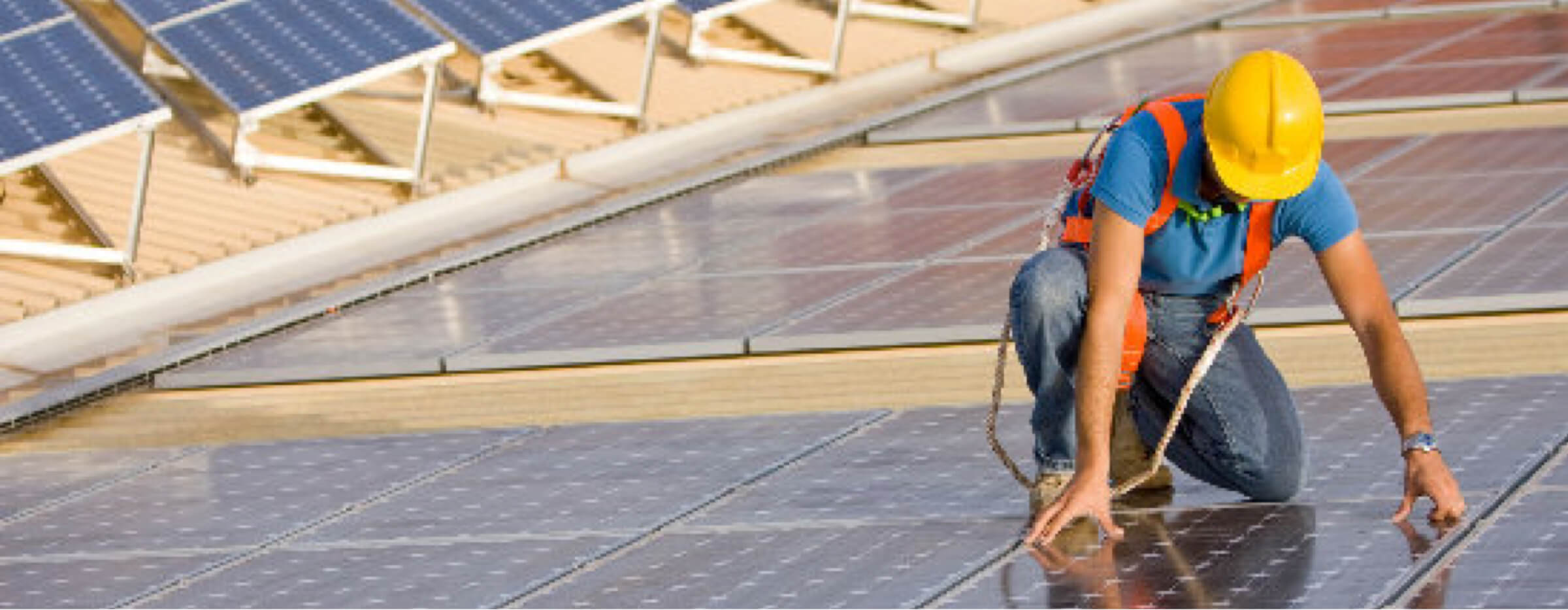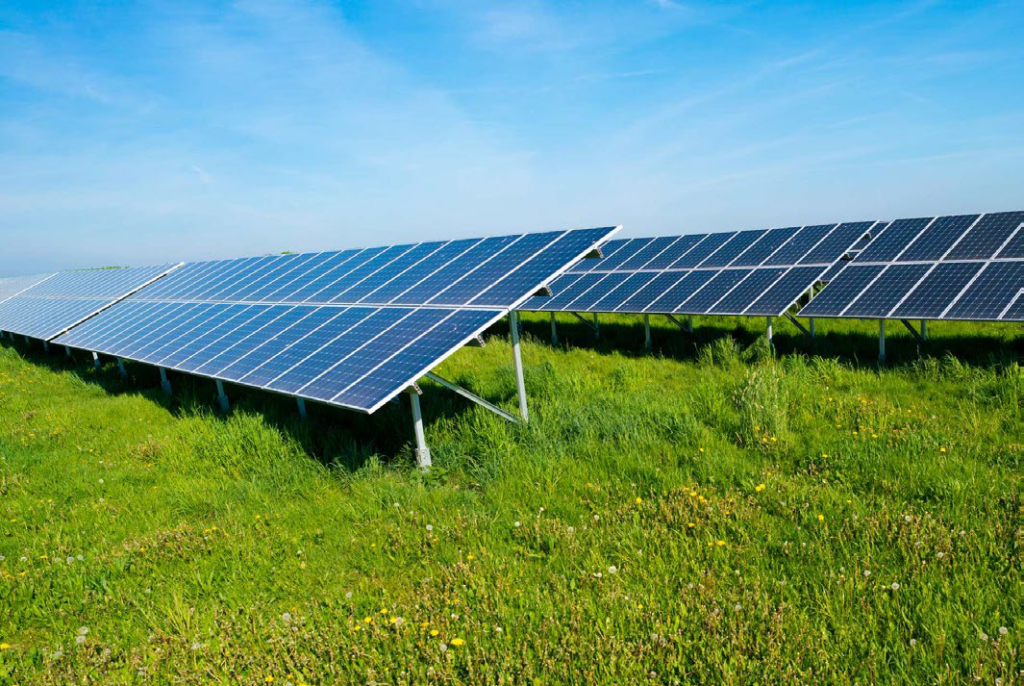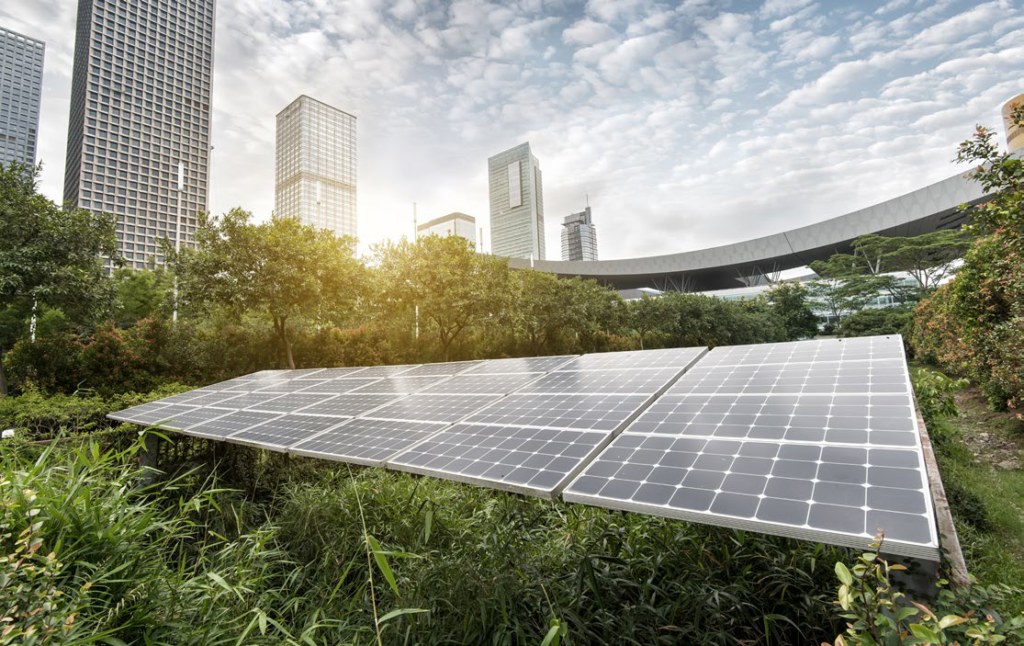Insight
Third-Party Owned and Operated Solar Power for Commercial Real Estate Owners
February 10, 2021 | BY Cresa Minneapolis

LOWER OPERATING COSTS, ZERO UPFRONT INVESTMENT, AND NO MAINTENANCE
Energy consumption is the single largest contributing factor to operating expenses for commercial office buildings in the United States. One-third of most operating budgets is allocated to energy use, and as much as thirty percent of the energy that buildings consume is used inefficiently or unnecessarily. This presents an opportunity for property owners to identify and adopt cost-saving practices that will improve their building’s energy efficiency and reduce its operating costs. Fortunately, for these forward-thinking CRE owners, solar energy is one of the most effective solutions.
Historically, the purchase and installation of solar panels required significant upfront costs and investment-grade credit, additional time and resources to identify and collect on government incentive programs, and the manpower and technical expertise to manage ongoing maintenance and operations. While the long-term financial and environmental benefits of these systems was appealing, many companies struggled to supply the criteria for its initial development.
This created an opportunity for third-party solar developers to profit from ample, government-sponsored solar incentives by managing the financing, construction, and maintenance of solar installations on behalf of property owners. All they needed was the space. Today, there are many solar developers who will pay to lease space on your roof or land, where they will fully fund, build and maintain a solar installation for the duration of the lease. In addition to a steady stream of rental income, the property owner also secures reduced energy rates over a long-term period, helping to reduce operating costs.
Commercial Solar Power 101
In commercial real estate projects, the most common type of solar installation is a grid-tied photovoltaic system. Photovoltaic panels convert sunlight into direct current electricity, which is then converted to alternating current electricity — the kind that powers most appliances in the United States. The property owner remains connected to the local utility grid, which can supplement the solar power generation during periods of minimal sunshine or surges of demand in power supply. As such, a grid-tied system reduces (rather than completely replaces) the power currently emitting from the electric utility.
What Property Types are Right for Solar?
Does your building have a large, open roof or an expansive parking lot where solar panels could be installed to form a canopy? These types of structures are ideal for solar installations. But your building’s structure is only one factor in considering the potential success of a solar project.
Other criteria include:

Geography:
- Region receives substantial sunlight
- State has pro-solar policies and incentives

Property Characteristics:
- Uses large amounts of electricity (generally more than 200,000 kWh annually)
- Minimum of 10,000 square feet that is both unshaded and available for the installation

Financial Criteria:
- High, local energy costs
- Property owner demonstrates credit worthiness (investment-grade credit or equivalent)
New and existing buildings are both ideal sites for solar installations. While these systems typically supply industrial structures, they can also be highly effective on corporate campuses with sufficient open land, parking area, or roof space.
Based on local energy rates, government incentives, and the quantity of sunshine, property owners within the following states are able to calculate a profitable return on their investment within the first year:
- California
- Massachussetts
- New Jersey
Secondary markets include Maryland, Pennsylvania, Ohio, and Illinois; and tertiary markets include Arizona, New Mexico, and Colorado.
A Massive Market Opportunity
During the past ten years, the price of solar panels has dropped dramatically and solar installations have grown significantly. This has driven down the cost of solar energy to —


Primary market able to calculate a profitable return on their investment within the first year
Secondary market able to calculate a profitable return on their investment within the first year
Tertiary market able to calculate a profitable return on their investment within the first year
— the point that it is now at grid parity with retail utility prices. This means that the cost of energy produced from the sun is equivalent to your local utility company’s electric rates.
In addition, many states offer attractive solar incentives to encourage job creation and meet clean energy goals. States also have mandates that require power companies to meet certain requirements for alternative energy, such as 20 percent alternative energy by 2020. In turn, utility companies offer incentives to real estate developers and property owners to integrate alternative energy sources into their operations.
This ideal environment has fed billions of investment dollars into companies to specifically fund solar projects, while large corporations like Walmart, Apple, and Ikea have built dozens of solar plants at their facilities.
The Financials of “Free” Solar
Third-party solar developers own and operate their projects. They pay to lease space from a property owner, invest the required capital to develop the solar installation, and work in financing structures with banks to make efficient use of available tax credits and other tax benefits related to using a solar array.
The contract for these third-party solar development projects is called a Solar Power Purchasing Agreement (SPPA), which offers property owners an alternative to financing and owning a solar panel system. This contract is similar to a traditional Power Purchasing Agreement (PPA), which defines the commercial terms for the sale of electricity between a utility and an electricity buyer.
Benefits of a SPPA:
- No upfront cost to buy solar power
- Provides pre-determined electricity rates for the term of the contract (typically 15 to 20 years)
- Offers expert production monitoring and metering
- No responsibility for equipment operations or maintenance
- Potential to help meet your company’s environmental policy objectives
- Option to purchase the system at fair market value after a set time-period
With these benefits come the challenging intricacies of negotiating with third-party developers versus purchasing a system outright. A SPPA may also not be the most effective strategy for property owners when the needs of the tenants do not necessarily align with theirs. If capital improvements are paid for by property owners, and energy bills are paid by tenants, this would negate any incentive for property owners to invest in energy-saving technologies. Alternative financing options exist that better address the landlord-tenant relationship.
Alternative Financing: PACE Loans
Property-Assessed Clean Energy (PACE) loans offer financing to commercial and industrial property owners and are repaid using an annual assessment on their property tax bill. This assessment leverages the general alignment of energy efficiency improvements and property taxes. Property owners pay both energy costs and property taxes in owner-occupied buildings and under gross lease structures, and pay neither under “triple net lease” structures where the tenant is responsible for property taxes and other property costs. Small and medium-sized businesses that do not possess investment-grade credit can also benefit from PACE programs.

How much does a single solar panel cost? Since 2008, panel prices have dropped 90% and currently average
$250 per panel.
Case Study: Patterson Companies

THE CALIFORNIA SUN BEATS DOWN ON A BRAND NEW SOLAR ARRAY ATOP PATTERSON CAOMPANIES’ 210,000 SQUARE FOOT DISTRIBUTION FACILITY IN DINUBA, CALIF.
Patterson Companies owns and operates more than 17 distribution facilities across North America to fulfill orders for their dental and veterinary products. To reduce the company’s operating expenses, they reached out to Cresa for help with performing an energy audit to identify opportunities for cutting costs.
The Ideal Location: Dinuba, California
Together with engineering firm DLR Group, Cresa explored alternative energy systems and the related incentives. They recommended the company’s Dinuba, California facility as an ideal location for a solar development due to the region’s high energy costs, state incentive programs, and high energy use; and the building’s large, flat roof.
Third-Party Solar: No Capital, No Maintenance
Patterson Companies was receptive to a solar development, but was not interested in funding the installation or maintaining the panels. Cresa developed a Request for Proposal (RFP) for the project based on the company’s criteria, identified three reputable third-party solar developers, and selected Renewable NRG Systems (NRG), a sustainable design and manufacturing company based in Vermont. Cresa then negotiated the terms of the lease for rooftop space and the energy Connection Agreement.
The First Step: Low-Hanging Fruit
Before launching into solar development, Cresa, NRG, and DLR Group worked closely with the Dinuba distribution center manager, Paul Schutz, to execute simple, cost-effective energy efficiency upgrades that would reduce the company’s overall energy usage and maximize future solar benefits.
SOLAR TERMS TO KNOW
- Kilowatt (kW): A unit of electric power needed to operate equipment. Equals 1000 watts.
- Kilowatt-hour (kWh): The most commonly-used unit of measurement indicating the amount of electricity consumed over time. It means one kilowatt of electricity supplied for one hour.
- Megawatt (MW): Equals 1,000 kW or 1,000,000 watts. According to the California Independent System Operator, one megawatt of utility-supplied power is enough electrical capacity to power 750 average-sized homes.
- Net metering: A process that utility providers use to credit property owners for the electricity they do not consume from their solar project.
Photovoltaic systems are categorized by their maximum capacity in kilowatts and their forecasted generation of electricity in kilowatt-hours per year. A system’s generation depends on local geographic and environmental conditions, primarily how much sunshine the location receives.

2,664 Solar Panels
One year later, the Dinuba facility now hosts a nearly one-megawatt rooftop solar array comprised of 2,664 photovoltaic panels, which are each capable of producing 340 watts of energy. As a result, the solar installation is expected to cut the building’s energy costs by 50 percent.
The installation was fully funded by NRG, which will also maintain the panels, monitor the solar array’s performance, and make adjustments as needed over the term of the lease.
Going Solar: What to Expect from a CRE Solar Installation Project [From Start to Finish]
If you are considering a solar development for your property, the first step is to assess your current energy costs and efficiency. How much energy do you use now, and how much do you spend on kilowatt-hours? This will help you assess how much you can save with a solar installation. By exploring your energy efficiency early on, you can reduce your building’s energy consumption, cut costs and advance any clean energy goals your company may have.
Where to look for easy, energy-saving opportunities:
- Lighting
- HVAC
- Building envelope (foundation, roof, walls, doors, windows, ceiling, barriers, and insulation)
- Water or pool pumps
- Any device that draws electricity 24-hours a day
Identify Possible Locations
Most solar installations require a minimum of 10,000 square feet to be effective. This space can be located on a roof, parking structure or vacant land. The ideal site is flat, unshaded, and has full access to south or southwest facing sunlight. For roof installations, it is important to consider the age and condition of your roof. Solar arrays are best installed on new roofs, although it is possible to conduct roof repairs with an installed solar array.
Select a Solar Provider
Lease durations will vary depending upon the third-party solar developer, but space is typically leased for 15 to 20 years. Entering this type of long-term contract requires choosing a company that is not only reputable and highly experienced in similar projects, but also a trustworthy and reliable partner who will stand the test of time. Solar providers are typically selected through a RFP process, which identifies the site-specific requirements and generates contractor bids for the project.
Contract Negotiations: The Solar Power Purchase Agreement (SPPA) and Lease
A SPPA is a complex legal document, which includes the lease and energy Connection Agreement. It is important to work with an experienced professional to negotiate the SPPA and represent your company’s interests. Negotiations may take several months, and will be impacted by obtaining necessary project approvals and permits, and securing financing and incentives.
Critical considerations that should be part of the lease include:
- What are the terms of the lease?
- How will solar energy be metered and monitored?
- Who will perform necessary maintenance on the solar array?
- If the roof requires replacement in the future, who will be responsible for removing and replacing the panels?
- If the building is sold, is the solar installation assumable by the next owner?
- Do negotiations favor one party in particular?
- Will excess energy go into the grid?
- Who is responsible for removing the solar system at the end of its functional life?
- How should rent revenue (rent paid to the property owner by the solar developer) be structured?
- What are the insurance requirements?
Feasibility + Due Diligence
It is vital to quantify the risk and potential value a solar system may bring to your property. Feasibility studies and due diligence reports provide critical details on market issues such as available rebates, expected lifetime revenue, and the potential impact on property value.

THE SOLAR INSTALLATION WILL CUT THE BUILDING’S ENERGY COSTS BY 50 PERCENT.
Site due diligence may include a real estate analysis, technical survey and relevant zoning codes (for vacant land), permitting factors, a roof warranty, structural impact report, and roof conditions survey. The feasibility study should consider all issues that could potentially affect the system’s energy production. The study should include a shading analysis and a meteorological review to establish how local weather trends will affect energy output.
Up on the Roof: The Installation Process
The solar services provider will lead the design and installation process, working closely with you and your electric utility provider. As most of the work will be performed on a rooftop (or over vacant land), the installation places minimal impact on the day-to-day functions within the building.
Will it Damage your Roof?
Many property owners are concerned about the impact to their building. However, solar arrays are typically beneficial as they are ballasted and placed on rubber sheets; therefore, there is no roof penetration or structural damage incurred. In fact, solar panels will extend the life of a roof as they block UV lights, which is the number one cause of roof degradation.
Commissioning
Once a system is installed it cycles through a commissioning process wherein the utility provider checks the interconnection, local inspectors ensure that the wiring complies with national and local electrical codes, and the installer confirms that the system is producing power as expected.
What if it Hails? Ongoing Maintenance and Monitoring for Long-Term Solar Efficiency
Periodic maintenance is necessary to keep solar arrays operating at their maximum efficiency. Solar panels are surprisingly durable, including holding strong against hailstorms, and typically require only rainwater as a primary cleaning source. The panels may need to be washed occasionally in dry, dusty climates, and heavy snow will need to be removed. In addition, software can track energy usage in the building and solar production on the rooftop, and will issue an alert if there is a problem with the system.
Whether you want to perform the maintenance on your solar array, or you want the solar developer to be responsible, someone will need to oversee periodic maintenance and any necessary repairs.
A Long-Term Bet: The Future of Solar Energy
Published in 2015, MIT’s extensive, 365-page study on the future of solar energy states, “Solar electricity generation is one of the very few low-carbon energy technologies with the potential to grow to very large scale.” In fact, the study’s researchers believe that solar energy has the potential to generate multi-terawatt-scale power.
Today, solar energy is a multi-billion-dollar industry.3 As the cost of solar equipment continues to drop, larger and larger installations are being constructed around the world. The most substantial project to date is a 750-megawatt power station in Madhya Pradesh, India, which is expected to be completed this year.
Additionally, ongoing research is constantly advancing solar technology. Building-integrated photovoltaics (BIPV) allow developers to infuse solar cells directly into a structure’s outer layer. Best suited for new buildings, BIPV can replace traditional building materials with solar materials, offering savings in construction material costs and energy consumption. Some of these innovative advancements include:
- Semi-transparent, thin solar panels used in place of traditional windows
- Solar thermal systems that can capture heat energy to generate usable hot water or provide space heating and cooling capacity
- Solar shingles that can be mounted inplace of standard roof shingles (available from Tesla in 2018)
- Photovoltaic paint which collects energy from sunlight and converts it into electricity
THE LONG VIEW
The average operable lifespan of a solar array is 30 years. Major solar panel manufacturers typically guarantee that panels will maintain 90 percent of their original output for ten years, and approximately 80 percent after 25 years. On average, solar output decreases by 0.5 percent for every year it is in operation.
Whether implementing energy-efficient retrofits into an existing building or developing a solar panel system from scratch for an out-of-the-ground building, efforts to reduce energy consumption for property owners and their tenants afford a positive return on investment. Benefits may also include substantial tax savings for building owners, tenant retention based on increased comfort and a more appealing aesthetic and, of course, reduced greenhouse gas emissions. Selecting trustworthy and proven experts will allow an organization to secure predictable, long-term energy savings and will contribute immensely to the growth of their sustainable future.
For guidance as to whether a solar installation is right for your property, and for expertise navigating the SPPA and lease negotiation process, contact the Cresa office nearest you.
1 Energy Star, “Commercial Real Estate: An Overview of Energy Use and Energy Efficiency Opportunities.”2. Energy Star, “Facts and Stats”. 3 SolarKal, “How Commercial Real Estate Owners Can Easily Make Money from Solar Energy” 4 SEIA, “Solar Means Business 2014: Top U.S. Commercial Solar Users” 5 SEIA, “Building Integrated Photovoltaics”
